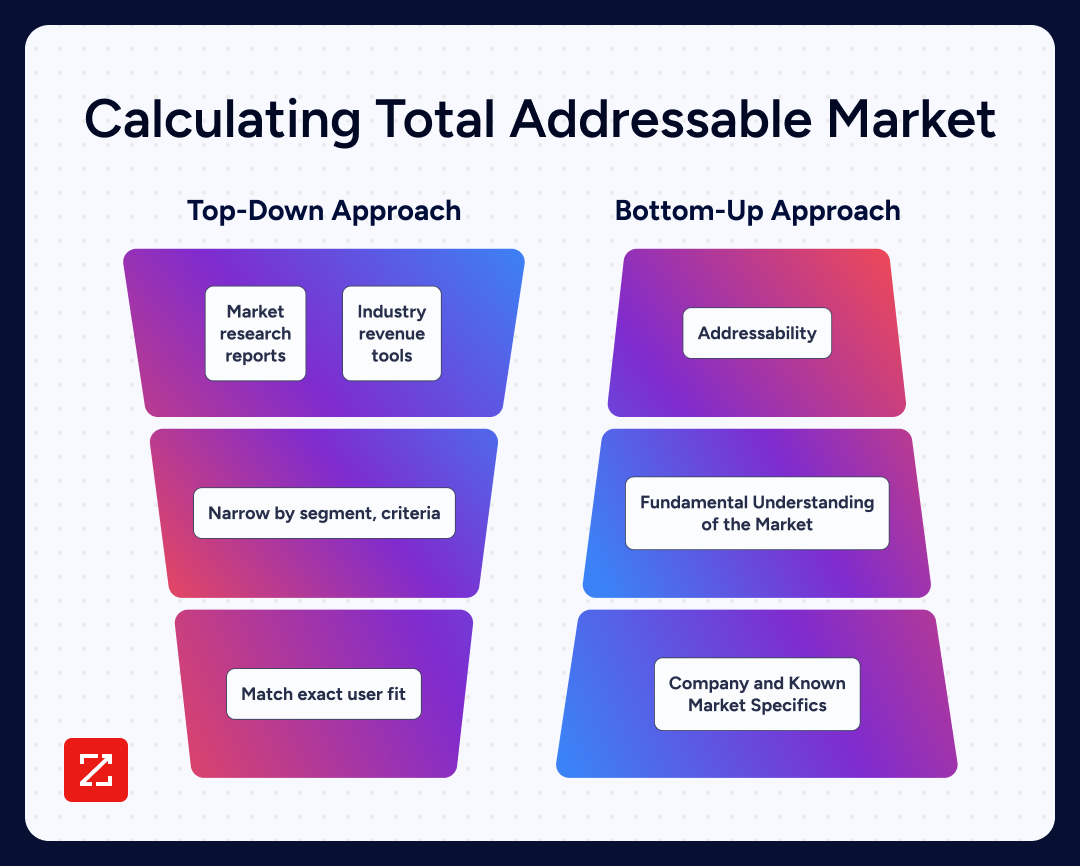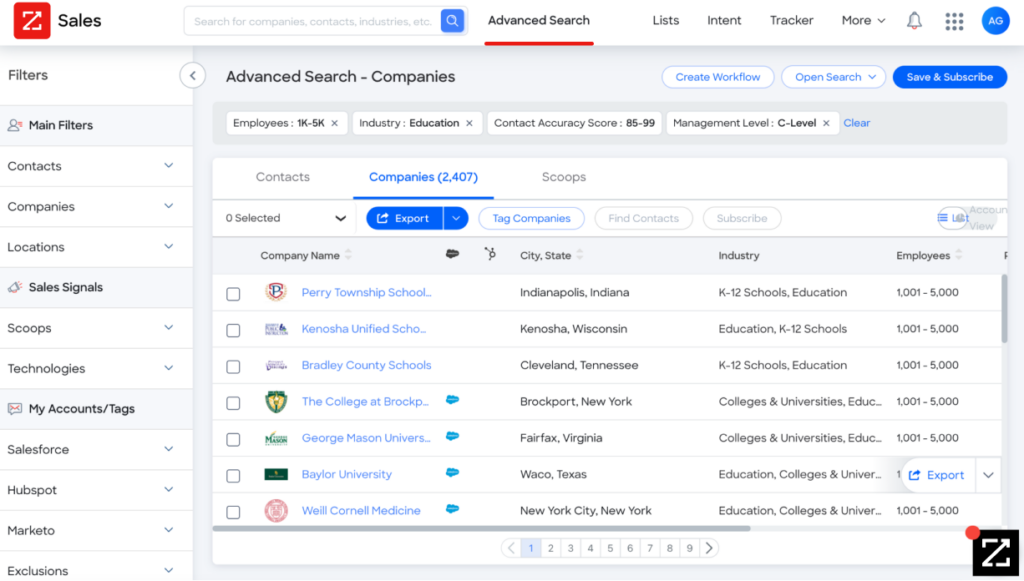Quick Summary
What is TAM?
Total Addressable Market or Total Available Market, also referred to as TAM, is a monetary value that represents all of the selling opportunities for your business. Read More
How Do I Calculate TAM?
You can calculate your TAM with a simple formula, but trustworthy results require market research and accurate data. Learn the Methods
Why Do I Need to Find My TAM?
Provide key stakeholders with an educated estimate of how much potential revenue can be gained. Learn Why
Launching a new product, entering a new market, or kicking off a keystone campaign are all moments when your go-to-market team can shine.
But before you begin building prospect lists or spinning up content and offers, you’ll need to define the scope of your opportunity with a rock-solid total addressable market (TAM) analysis.
Defining your market today — and understanding where your business can grow in the future — helps go-to-market professionals focus on the right customers and competitors at the right time. And the quality and breadth of your market intelligence data makes all the difference.
What is a Total Addressable Market?
Your Total Addressable Market (TAM) is the broadest possible picture of prospects that could potentially use your product or service. It’s often expressed in terms of total revenue or number of customers.
What’s the Difference Between SAM and TAM?
While TAM is your Total Addressable (or available) Market, the acronym SAM is sometimes used to describe a Serviceable Addressable Market — and they are unlikely to be equal. While the TAM outlines the broad market opportunity, the segments within your reach are your SAM.
Defining the difference between these values can give your team more realistic revenue goals for your marketing and sales strategy.
How to Calculate the TAM for Your Products or Services
Calculating your TAM requires market research and data analysis. Consider firmographic factors like industry, revenue, size, and geographic location.
Two common approaches to TAM calculation are top-down and bottom-up.

1. Calculate TAM Using a Top-Down Market Size Approach
With the help of secondary market research from analyst firms like Forrester or Gartner, you get a better idea of how many potential users meet your market criteria — including how big that industry is.
It helps to think of this method as an inverted pyramid, where the smallest point represents the end-user. However, external research may not meet the exact specifications for your addressable market, and estimations may carve out or tack on additional segments that make your estimate less reliable.
Calculating Total Addressable Market with a data management platform like ZoomInfo only takes a few steps:
Define the criteria: Determine the specific firmographic criteria for companies and contact attributes, such as job levels/titles, industries/NAICS/SIC, employee/revenue, etc.
Gather data: Obtain a list of companies or contacts based on the provided filters.
Import data: If a list of companies or contacts is available, import the file using the Snowflake import template.
Match and deduplicate: Join the table with the imported file and match it. Ensure there are no duplicates in the temporary table.
Analyze and export: Analyze the data and export the counts or a sample of contacts, ensuring that the number of contacts in the results does not exceed the total number of contacts in the database.
These steps will help in calculating the Total Addressable Market based on specific firmographic criteria for companies and contact attributes.
2. Calculate TAM Using Using a Bottom-up Market Size
The bottom-up approach is more reliable, since it uses first-party data to provide a more accurate estimation of revenue and market growth.
To calculate your market size using a bottom-up approach, multiply the total number of accounts in your industry by the annual contract value (ACV) of your company’s product or service.

For example, suppose you have a beverage company that could sell lemonade to 1,000 vendors on the West Coast. Each case of lemonade costs $30, and on average your vendors buy 50 cases per year, totaling $1,500.
You can calculate your TAM for the West Coast by multiplying 1,000 vendors by $1,500, which equals a total market of $1.5 million.
Derive more value from this TAM equation by digging deeper and grouping accounts by size. One way to do this: multiply ACV by the number of accounts in small and medium-sized businesses (SMB), mid-markets (MM), and large enterprises (EE):

By accounting for the variability in account sizes, the bottom-up equation provides a more accurate estimate of your total addressable market, as well as insights into valuable sub-segments to pursue. When relying on a foundation of highly accurate data, this approach provides a more detailed, accurate picture of your TAM, which translates to higher revenue.
Continuing the beverage company example, you could examine the different business accounts within your vendor list. Out of the 1,000 vendors that you could sell to, let’s say you identify that 659 are SMBs, 166 are mid-market, and 175 are large enterprises (EE). Your ACV for SMB, mid-market and enterprise might be $500, $2,000, and $5,000 respectively.
Therefore, you would calculate the sum of ($500 x 659 SMBs) + ($2,000 x 166 MM) + ($5,000 x 175 EE) to equal a total addressable market of $1.53 million.
Ready to Try it Yourself?
ZoomInfo’s TAM Calculator is a free resource that lets any GTM professional quickly begin their TAM analysis.
Why Is TAM Important?
The more targeted, precise, and personalized a marketing strategy is, the better its performance. Your TAM is a big factor in making sure you’re getting the most out of your marketing efforts because it shows the potential outcomes of a business opportunity.
Helps Explain Market Potential to Key Stakeholders
At the highest level, a well-calculated TAM helps your company explain its potential to investors, employees, and other key stakeholders. Investors and external partners want to know your company’s ambitions and understand the C-suite’s goals — but they also need to know that the math backs it up.
Inside the company, a well-formulated TAM guides your team toward a shared goal, and gives everyone a common gauge of how close they are to capturing a meaningful slice of the market.
Demonstrating to investors and partners that your strategies are supported by rigorous TAM calculations increases their trust in your business.
Establishing a clear TAM enables your teams to align around a unified goal, which helps manage internal expectations.
Presenting TAM to stakeholders not only highlights the available growth opportunities but also provides a benchmark for measuring business success.
Guides Your Budgeting and Investment Decisions
At a more granular level, a well-considered TAM calculation can help guide your budgeting and investment decisions for better resource allocation. Once your TAM is defined, your marketing teammates will know which segments of the market to focus on next — and will have a clearer understanding of how their efforts are translating into bottom-line results. Specifically:
Understanding TAM allows you to prioritize spending on marketing and sales initiatives that target the most lucrative market segments.
Identifying the full potential of your market with a TAM analysis helps in assessing the risks associated with different market segments in competitive industries.
Knowing your TAM improves the accuracy of your sales forecasts by providing a clearer picture of potential market penetration and growth — supporting better financial planning.
Getting beyond the numbers is the key: once you truly understand the characteristics of your market, you will begin to ask what motivates your prospects. And putting yourself in the buyer’s shoes gets you one giant step closer to winning their business.
Identifies and Prioritizes Customer Segments
How can you know which segments within your TAM has the highest revenue potential? Such a critical question can be answered with an accurate view of your TAM. If you really want to get specific with the nuances of your TAM, the right TAM data can tell you:
The ideal customer profile (ICP) within your total addressable market
The total addressable market of business professionals for your products or services
The ideal persona profile of business professionals within your total addressable market
Where Do You Get Accurate Data to Determine Your TAM?
To identify companies in your TAM, use your B2B database to filter by industry, company size, and location. You should have enough filters to narrow in on a target market, but not so many that your market opportunities become too small.

To prioritize which accounts to target first, break down your TAM into micro-TAMs based on industry and headcount. Now you can see where you win big and often, compared to markets with smaller deal sizes and higher loss rates.
For example, you may win more with small-to-midsize healthcare companies than with enterprise financial companies.
Questions to Ask to Help Define Your TAM
Finding your TAM gets easier when you know to ask the right questions. Consider the following as you define your total addressable market:
What is the size of the target market?
What are the demographics and firmographics of potential customers?
What are the ideal customer profiles based on data attributes such as industry, number of employees, and location?
Are there any specific attributes such as department, role, and title level for individual records that need to be considered?
How do you prioritize accounts based on demographic, behavioral, and intent scoring values?
Go to Market Smarter with AI
Beyond being a metric of potential revenue, your TAM calculation is a pivotal tool that drives focused, informed, and effective business strategies across all levels of your business. Once your TAM is defined — it’s time to go to market. Find out how ZoomInfo Copilot helps companies of all sizes sell smarter and win faster with AI-fueled buying groups, smart account summaries, and personalized outreach based on the world’s most comprehensive, accurate B2B data and buying signals.


